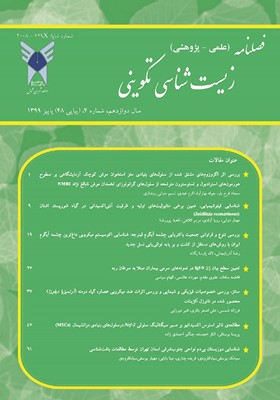بررسی اثر تنش ناشی از شوری بر تکوین اندامهای رویشی در گیاه لیف (Luffa cylindrica L.)
محورهای موضوعی : زیست شناسی سلولی تکوینی گیاهی و جانوری ، تکوین و تمایز ، زیست شناسی میکروارگانیسم
سایه جعفری
1
*
![]() ,
معصومه ماهوت فروشها
2
,
معصومه ماهوت فروشها
2
1 - گروه زیست شناسی دانشگاه آزاد اسلامی واحد تهران شمال، تهران، ایران
2 - گروه زیست شناسی دانشگاه آزاد اسلامی واحد تهران شمال، تهران، ایران
کلید واژه: تکوین, تنش شوری, گیاه لیف, اندام رویشی,
چکیده مقاله :
گیاه لیف (Luffa ) گیاهی علفی، یک ساله با ارزش اقتصادی و دارویی بالا متعلق به تیره کدوئیان است. با توجه به معضل شوری در کشور، در این پژوهش تاثیر تنش شوری بر تکوین اندام رویشی گیاه لیف مورد بررسی قرار گرفت. بذور تهیه شده در گلدان (شاهد و 3 تیمار هر کدام با چهار تکرار) کشت شدند و دو هفته قبل از گلدهی تحت تیمارهای 15، 30 و 45 میلی مولار کلرور سدیم با شرایط آبیاری قطره ای قرار گرفتند. به منظور بررسی تکوین اندامهای رویشی، ریشه، ساقه، برگ، دمبرگ در فیکساتور گلیسرالدئید تثبیت و از روشهای رایج بافت شناسی برای تهیه برشها استفاده شد. مریستم رویشی، در مراحل مختلف برداشت، در FAA 70 تثبیت و در الکل70 % نگهداری و با میکروتوم برش گیری شد. رنگ آمیزی با PAS و هماتوکسیلین انجام گرفت. نتایج نشان داد افزایش تنش شوری موجب کاهش ارتفاع ، فاصله میان گره و اندازه کلی گیاه شد. با افزایش غلظت نمک وسعت ناحیه پارانشیم پوست کاهش، قطر و تعداد عناصر متاگزایلمی در ریشه افزایش یافت. ساقه با افزایش غلظت نمک زودتر به مرحله ساختمان پسین وارد شد و تعداد لایههای سلولی و فعالیت لایه زاینده افزایش یافت. در برگ در تیمارهای مختلف نمک افزایش تعداد لایههای پارانشیم نردبانی، کاهش فضای بین سلولی، کوچک تر شدن بافت مزوفیل برگ، افزایش تعداد و طول کرک مشاهده شد. در راس رویشی ساقههای تحت تیمار، تغییر شکل مریستم از شکل رویشی به مرحلهای شبیه مریستم زایشی با رنگ پذیری همگن مشاهده شد که نشانه پیری زودرس گیاه است.
Luffa cylindrica L. (Cucurbitaceae family) is an herbal plant with high medicinal and economical usage. Due to the salinity problem in soils of the country, the effect of salinity stress on the development of vegetative organs of luffa was investigated. Seeds were planted in pots (control and 3 treatments with four replications) and treated with 15, 30 and 45 mM NaCl under drip irrigation two weeks before flowering. The root, stem, leaf and petiole of plants were fixed in Glyceraldehide fixator solution. The common methods of cell – histology was used for preparing of section. Vegetative meristem was removed in different stages, fixed in FAA70% and maintained in ethanol70%. The microtome was used for vegetative meristem sections and staining was carried out with PAS (Periodic Acid Schiff) and Hematoxyline. The results showed increasing salinity decreased the height, internode distance and overall size of plant. Increasing salt concentration causes the growth in the thickness of methaxylem elements at the root, leads the stem to go to subsequent structure earlier than normal process, have the cell layers increase in number, and increase the activity of the generative layers. In leaves, findings also showed that different salt concentration lead to increasing of ladder parenchyma layers, number and length of trichomes. Under the treatment meristem vegetative tip of the stem was layered. At the higher concentration vegetative tip became wide and got homogeneous pigment similar to what is seen in generative meristem. This phenomenon can be the sign of premature aging of the plant.
_||_

